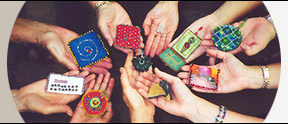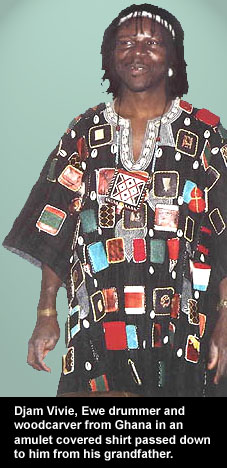 |
 |
 |
 |
 |
 |
 |
 |
 |
 |
|
The concept of creating amulets with potent contents is influenced by traditions among different peoples from the African Diaspora.
Sealing the writings inside the beaded packets borrows from the African amulet tradition that inspired the project. Historically, African amulets are made from leather or cloth casings filled with sacred writings and other tokens of power. Closing the amulets makes their contents inaccessible. For the amulets that contain writings it is the presence of the word, not the ability to read it, that yields their power. The casing acts as a veil elevating the contents to an intangible and metaphysical realm. The power of secrecy as discussed in Mary Nooter's "Secrecy: African Art that Conceals and Reveals" (1992), is a significant factor in the healing process for many. To one participant in the Beaded Prayers Project, an adult survivor of child abuse, the sense of anonymity was the most meaningful aspect of the project. For others the familiarity of keeping a wish secret like one does when blowing out birthday candles is a familiar device. Craft processes such as beadwork and embroidery have been used as a means to unify, heal, and serve individuals and communities because they are functional, familiar and often considered soothing. A well known example of a contemporary collaboration using a craft tradition is the Names Project AIDS Memorial Quilt. The Names Project grew out of the tradition of mourning quilts. Started by a small group of San Francisco quilters, the first public exhibition of the Names Project contained only forty blocks, each with the name of a loved one who had died from AIDS. Two years later the project had grown to include over ten thousand blocks and weighed thirteen tons. The amulets in the Beaded Prayers Project are smaller, lighter, and more portable than the quilt blocks in the Names Project, yet the power of accumulation is as essential. The project continues to grow simply by word of mouth and the "each one teach one" model. |
 The amulets of the Akan people in Ghana are called bansuri.
The Hausa and Yoruba people of Nigeria make tira, Afro Brazilians make patua, Bakongo peoples in the Congo make minkisi, and African Americans in the United States call their amulets mojo.
The physical manifestation of prayers and amulets is ubiquitous and connects to other cultural traditions as well- doaa nameh in Iran, scapulars for Catholics, and mezuzahs in the Jewish tradition.
The project has proven to be quite multicultural in its appeal.
The amulets of the Akan people in Ghana are called bansuri.
The Hausa and Yoruba people of Nigeria make tira, Afro Brazilians make patua, Bakongo peoples in the Congo make minkisi, and African Americans in the United States call their amulets mojo.
The physical manifestation of prayers and amulets is ubiquitous and connects to other cultural traditions as well- doaa nameh in Iran, scapulars for Catholics, and mezuzahs in the Jewish tradition.
The project has proven to be quite multicultural in its appeal.